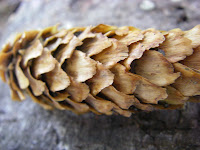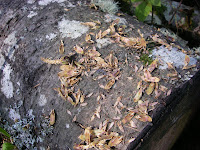 The old growth forests that remain in the northwest were another hearkening back to the days of the Corps of Discovery. At some of the trails around, they had these wonderful interpretive signs that quoted the original descriptions of the species near the sign from Lewis and Clark's journals. Here, a sitka spruce, large -- but not the largest we saw...
The old growth forests that remain in the northwest were another hearkening back to the days of the Corps of Discovery. At some of the trails around, they had these wonderful interpretive signs that quoted the original descriptions of the species near the sign from Lewis and Clark's journals. Here, a sitka spruce, large -- but not the largest we saw... their pine cones (above, whole and as a midden pile) support the chickaree, or Douglas squirrel. Dark and small, these fellows chirped quite loudly, and even showed their faces (unlike their Brownsea Island cousins) but would not stay still for photographs. So there's a blurry one.
 On these ginormous trees, a variety of lichens and mosses grow, and under them, ancient plants, like...
On these ginormous trees, a variety of lichens and mosses grow, and under them, ancient plants, like... ferns...
ferns...  and horsetails...
and horsetails... The fungi was spectacular, colorful, numerous, and mostly unphotographable -- it was almost as dark as night on the forest floor with so much growing above.
The fungi was spectacular, colorful, numerous, and mostly unphotographable -- it was almost as dark as night on the forest floor with so much growing above.
Here is some of what was making the shade...

Here are some of the forest's creepy-crawlier residents.
 The northwest is famous for its slugs; you cannot tell in this picture that this fellow is about the size of a big thumb.
The northwest is famous for its slugs; you cannot tell in this picture that this fellow is about the size of a big thumb. This caterpillar tried to fool me into thinking it was a dead leaf, but I'm too smart for that...
This caterpillar tried to fool me into thinking it was a dead leaf, but I'm too smart for that... There were lots of largish spiders there, this one having a little meal.
There were lots of largish spiders there, this one having a little meal.


No comments:
Post a Comment